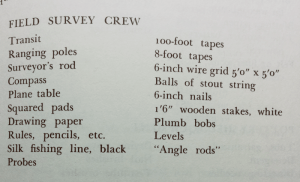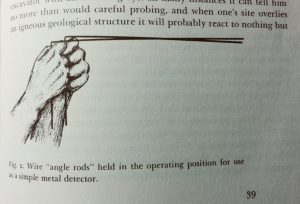
I like to read early writings on archaeology, comparing and contrasting what they did with what we do now. Antiquarians methods of the 19th century and even early archaeological methods of the 20th century are often fascinating, sometimes incredible, occasionally appalling. But they got us where we are today and I wonder if another 100 years from now, archaeologists will shake their heads in wonder, bewilderment, or dismay as they read our own works.
In leafing through Historical Archaeology by Ivor Noel Hume (1968, Knopf, New York), I came across a list of suggested equipment for the field survey crew (p. 63):

In the photograph of the page in the book, notice the last entry on the second column: “angle rods.” Nearly all of this list is still in use by archaeologists today and I recognized it all immediately. But the “angle rods” threw me. I simply could not figure out what they were. So I took care to focus a little more diligently in the text. On a previous page, I found discussion of “angle rods.”
As I have mentioned, wire coat hangers provide the most convenient raw materials, and one simply cuts two lengths, each measuring about two feet, with the bend coming eight inches from one end. Holding the wires very lightly, one in each hand, with the bend resting on the forefinger and the short end of the wire hanging down the rough the palm, one walks forward with the knuckles of each hand touching and the wires parallel and about two inches apart. (Fig. 2) As one approaches a buried metal object, the wires slowly converge until they forma cross close to the hands, and at that point the short ends of the wires projecting downward below the hands are the closest to the object. (p. 37)
Hume is describing dowsing rods! Needless to say, I rushed to turn the page to see figure 2!

Hume goes on to say,
There is no denying that one feels a little idiotic walking across a field intently watching two pieces of coat hanger. Nevertheless, they serve a useful purpose and are included in every Williamsburg archaeologist’s box of tricks. (p. 38)
“Witching” and dowsing for water, graves, and metals is still a thing. Two anecdotes I can share are this: about one year ago, I turned the corner in my small, country town and noticed the water department was doing some work. As I made my turn, I glanced out of the passenger side window of my car and noticed one of the workers holding dowsing rods that had handles that looked like bicycle grips. On another occasion, I was present when a local informant attempted to show me how to use his dowsing rods to “witch” for graves. Being ever polite, I held the rods which moved just as I expected as I traversed an uneven spot, but this was proof to him that I had the touch.
After he mentioned he can use these to find water in addition to graves, I asked the informant, a man I happen to like very much, a question: how does he know that what he’s found is a grave and not water? I didn’t ask to be obstinate or difficult, I was genuinely interested in how he thought about these things. He didn’t really have an answer and it actually seemed to make him think a bit.
I’ve previously written about grave dowsing as it related to an imminent domain case in Louisiana, where a farmer was trying to find good reason to prevent his land from being added to a local highway improvement. To test his claim, the archaeologists brought in a GPR unit to survey the site and found no evidence of burials.
Hume’s book is only less than 50 years old, yet he discusses dowsing on the same page as the proton magnetometer. What, I wonder, will be our “angle rods” from the point of view of future archaeologists?
I know this is an old article. However, as a Boy Scout we were taught the use of angle rods or divining rods. They were made of copper. And we used them to find water. In 1979 when my parents were building a house the well drillers couldn’t find a spot with water with the technology of the time. My dad who was a civil engineer asked one of the older guys who knew how to properly use the rods to come and check for water. He was able to locate and at what depth the well would hit water and at what depth to drill to. It took him about 15-20 mins he marked locations and went back to them to determine the best spot. In the almost 40 years the well has never run dry even in times of drought when our neighbors had dry wells. It stuck in my head because of the drought where our neighbors went dry. Because my mom said to my dad “if it wasn’t for that hokey diviner we would have run out of water” that was her version of admitting he was right. Sometimes we discredit something old as pseudoscience. Even though it has years of proven use. Good find article I did enjoy reading more on its background in archeology.
Thanks for commenting, even on an older post!
I definitely get what you’re saying about dowsing rods. And there are quite a few people in the area I live who swear by them. Unfortunately, I think even with the very personal anecdote you provided, dowsing is a practice that is only supported by confirmation bias. My guess is that there is (or was) and extensive water table or aquifer below your father’s property and it really wouldn’t have mattered where they drilled. Water would have been encountered they just drilled.
I’m not sure what they might have used in 1979 to pick a location for a well, but today most well locations are chosen based on proximity to sources of contamination (pesticide use, septic tanks, etc.) and below ground geology. People who put in wells typically have an understanding of the local geology and relative depths needed to go in order reach a water table. Sometimes people sink a well in bedrock and get water, but it’s limited based on the porosity and amount of fissures and joints in that geologic member. Often the aquifer is just below or above a bedrock layer –or both.
I’d be willing to bet had your father sunk the well directly *between* any two of the dowser’s marked locations he would have had a well that produced water. The question then becomes, what does this mean for the dowser? He was right, of course, with his “hits”–the places he marked. But what of his “misses?”
The dowser really didn’t have any. That’s because the places he marked were probably all from the same water table (aquifer). Of course, this all depends on the geologic stratigraphy, etc.
I suspect most people who practice dowsing also have an intuition of the geology needed. When you add that to the ubiquity of subsurface water, it would be difficult to say that they’re “frauds” or that the practice is “hokey.” But the plain fact is, when you test the practice of dowsing under rigid, scientific conditions, it does no better than chance. And, when you try to put forth a mechanism to explain why it might work, nothing passes the test of reason or logic.
I hope my answer and reply isn’t met with offense. I definitely understand that this is one of those things that is easily observed as having an effect by someone who seems experienced. It just doesn’t stand up to scrutiny.